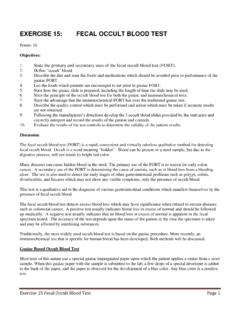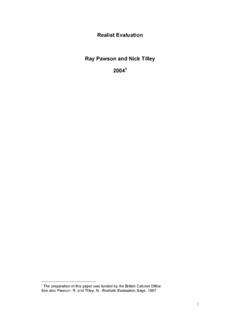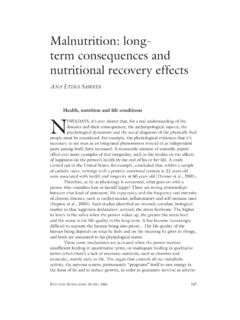Transcription of Infants and Young Children Vol. 16, No. 4, pp. …
1 LWW/IYCAS213-03 August 11, 20038:50 Char Count= 0 Infants and Young ChildrenVol. 16, No. 4, pp. 296 316c 2003 lippincott Williams & wilkins , SCERTS ModelA Transactional, Family-CenteredApproach to EnhancingCommunication and SocioemotionalAbilities of Children With AutismSpectrum DisorderBarry M. Prizant, PhD; Amy M. Wetherby, PhD;Emily Rubin, MS; Amy C. Laurent, OTR-LA range of educational/treatment approaches is currently available for Young Children with autismspectrum disorders (ASD). A recent comprehensive review by an expert panel on ASD (NationalResearch Council, 2001) concluded that a number of approaches have demonstrated positive out-comes, but nonetheless, not all Children benefit equally from any one approach.
2 Efforts to increasecommunicative and socioemotional abilities are widely regarded as among the most critical prior-ities, and growth in these areas is closely related to prognosis and long-term positive , some widely disseminated approaches are not based on the most contemporary de-velopmental research on social and communication development in Children with and withoutdisabilities, nor do they draw from current understanding of the learning style of Children withASD. This article describes the SCERTS Model, which prioritizes Social Communication, EmotionalRegulation, and Transactional Support as the primary developmental dimensions that must be ad-dressed in a comprehensive program designed to support the development of Young childrenwith ASD and their families.
3 The SCERTS Model has been derived from a theoretical as well asempirically based foundation and addresses core challenges of Children with ASD as they relate tosocial communication, emotional regulation, and transactional support. The SCERTS Model also isconsistent with empirically supported interventions and it reflects current and emerging recom-mended practices (National Research Council, 2001).Key words:autistic spectrum disorder,autism,developmental,early intervention,education,communication,emo tional regulation,family support,socialAUTISM SPECTRUM DISORDER (ASD) orPervasive Developmental Disorder (PDD)(APA, 1994) is a category of developmentalFrom Childhood Communication Services and theCenter for the Study of Human Development, BrownUniversity, Providence, RI (Dr Prizant); theDepartment of Communication Disorders, Center forAutism and Related Disorders, Florida StateUniversity, Tallahassee, Fla (Dr Wetherby); theCommunication Crossroads, Monterey, Calif(Ms Rubin and Laurent); and the Yale UniversityChild Study Center, New Haven, Conn (Ms Rubin).
4 Corresponding author: Barry M. Prizant, PhD,Childhood Communication Services, 2024 Broad St,Cranston, RI 02905 (e-mail: characterized by qualitative impair-ments in social interaction and social related-ness, difficulties in acquiring and using con-ventional communication and language abili-ties, and a restricted range of interests oftenco-occurring with an extreme need for con-sistency and predictability in daily living rou-tines. Frequently co-occurring and associatedcharacteristics include problems in sensoryprocessing (Anzalone & Williamson, 2000;Greenspan & Wieder, 1997), motor planning(Anzalone & Williamson, 2000; Prizant, 1996),emotional regulation and arousal modulation(Cole, Michel, & Teti, 1994; Dawson andLewy, 1989; Prizant, Schuler, Wetherby, &Rydell, 1997), and behavioral organization296 LWW/IYCAS213-03 August 11, 20038:50 Char Count= 0 The SCERTS Model297(Ornitz, 1989).)
5 The learning profile of chil-dren with ASD is typically uneven and inflex-ible, with relative strengths in object knowl-edge, rote memory, and visual-spatial process-ing, and weaknesses in social knowledge, se-mantic and conceptual memory, and abstractproblem-solving (Prizant, 1983; Wetherby,Prizant, & Schuler, 1997). ASD is now under-stood to be of neurogenic origin and is gener-ally considered to be a lifelong disability thatcan dramatically impact family members. Ad-vances in research on early identification haveresulted in earlier diagnosis of ASD (Lord &Risi, 2000). As a result, there is a great de-mand for current information on educationand treatment for Young variety of treatment approaches currentlyare available, ranging from educational to clin-ical to biomedical (eg, psychopharmacolog-ical, nutritional) (National Research Council[NRC], 2001).
6 Within the category of edu-cational and clinical strategies, efforts to in-crease communication and socioemotionalabilities are widely regarded as among themost critical priorities (NRC, 2001; Wetherby& Prizant, 2000). These difficulties virtuallydefine ASD, and progress in communicationand socioemotional development is closelyrelated to outcome and independent func-tioning. However, approaches to enhancingthese abilities vary greatly, resulting in con-fusion for caregivers and some source of this variability is the extentto which educational/treatment approachesare based (1) on current understanding of thelearning style and the nature of the disabilityof ASD, and (2) on the most contemporaryresearch on communication and socioemo-tional development in Children with and with-out disabilities.
7 On the one end of the con-tinuum, approaches that are developmentallybased draw heavily from the knowledge baseon typical child development (eg, Greenspan& Wieder, 1997; Gutstein, 2000; Prizant,Wetherby, & Rydell, 2000; Rogers & Lewis,1989; Wetherby et al., 1997). On the otherend of the continuum are more traditionalABA (applied behavior analysis) approaches,which are based primarily on teaching prac-tices derived from tenets of learning the-ory and operant conditioning (Lovaas, 1981;Maurice, Green, & Luce, 1996) (see Prizant& Wetherby, 1998, for further discussionof the continuum of educational/treatmentapproaches and the debate on efficacy ofintervention).
8 Over the past 2 decades, there have been in-creased attempts at cross-fertilization, withdevelopmental research and family-centered and child-centered practice influencing thecontent and teaching practices of traditionalABA approaches (Strain et al., 1992), re-sulting in a clear distinction between con-temporary ABA practice and traditional ABApractice. Similarly, developmental approachesare increasingly infusing tenets of ABA ap-proaches to address the need for consistency,intensity, and accountability, which havebeen strengths of ABA practice (Prizant &Wetherby, 1998). However, in our recent ex-perience, current educational/treatment pro-grams tend to fall into 1 of 2 , some programs continue to adhere toonly 1 or 2 approaches, with little integra-tion of practices from different contrast, other programs use a patch-work quilt strategy borrowing from differentpractices along the continuum, even whensuch practices are not easily integrated, re-sulting in a fragmented approach to program-ming.
9 For example, a Young child may re-ceive services in an integrated developmentalpreschool setting focusing on communica-tion, play, and peer interaction, but also re-ceive traditional ABA treatment in additionalhome-based therapy focusing on readinessskills and compliance training, with little co-ordination between settings. Such fragmenta-tion may cause confusion for Children who areexposed simultaneously to highly structured,directive approaches based on repetitiveteaching drills, as well as more loosely struc-tured, child-centered approaches using morenatural activities for teaching. It may alsoresult in considerable confusion for parentsand frustration for professionals who comefrom different, and sometimes diametricallyopposed, orientations.
10 Thus, there remainsLWW/IYCAS213-03 August 11, 20038:50 Char Count= 0298 Infants ANDYOUNGCHILDREN/OCTOBER DECEMBER2003a great need for a comprehensive educa-tional/treatment model with the following fea-tures: (1) the model is based on the most cur-rent research in child development and ASD;(2) it is flexible enough to incorporate differ-ent perspectives (ie, developmental and con-temporary ABA); (3) it can be applied in anindividualized manner while addressing the core deficits of ASD; and (4) it is family-centered, taking into account critical individ-ual differences across families in reference totheir priorities, and their involvement in criti-cal programmatic article provides an overview of theSCERTS Model, a comprehensive, multidisci-plinary approach to enhancing communica-tion and socioemotional abilities of childrenfrom early intervention to the early schoolyears.





